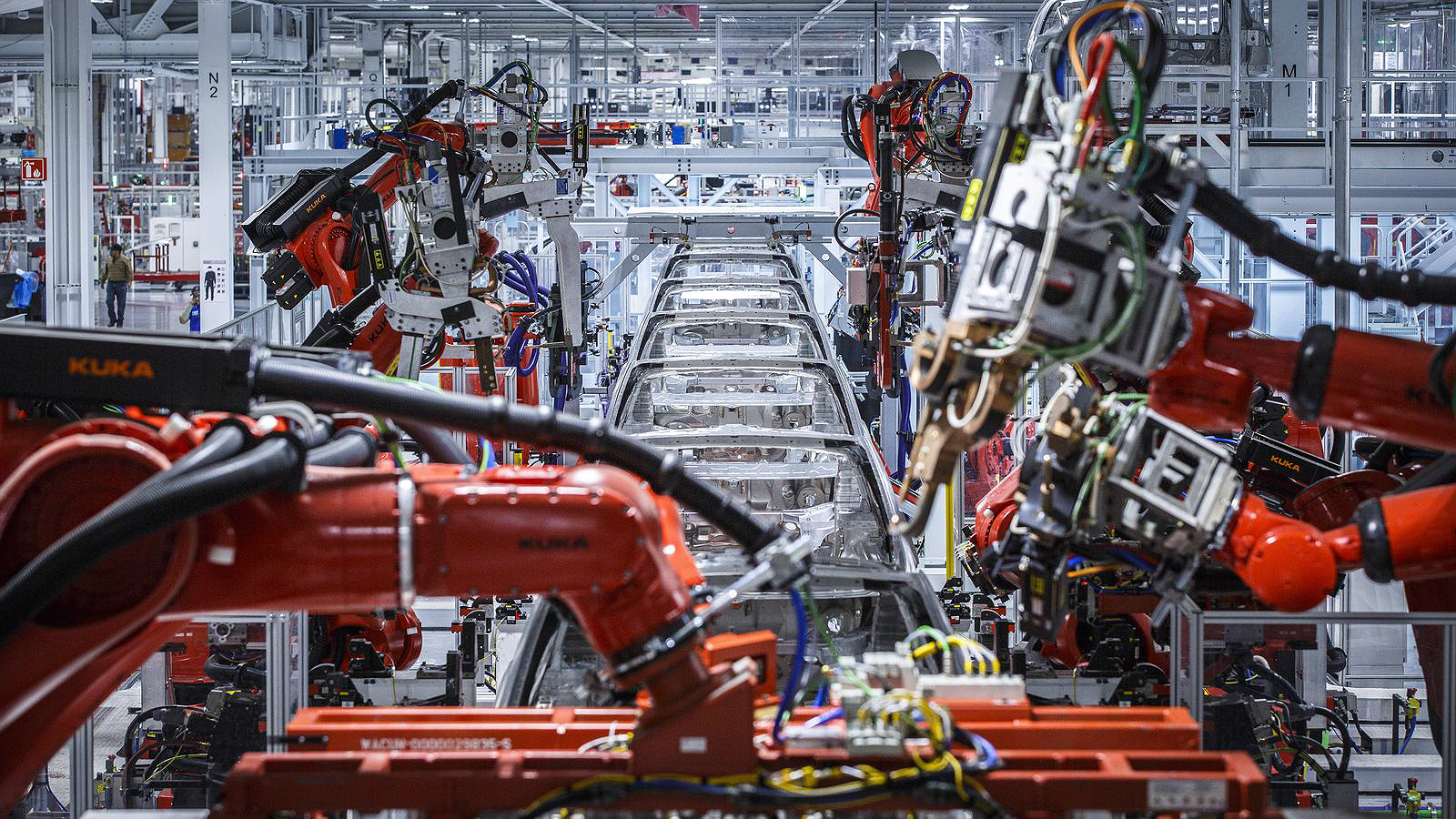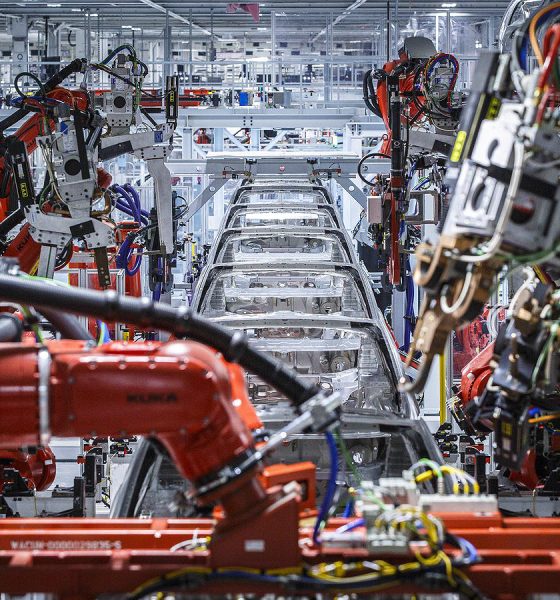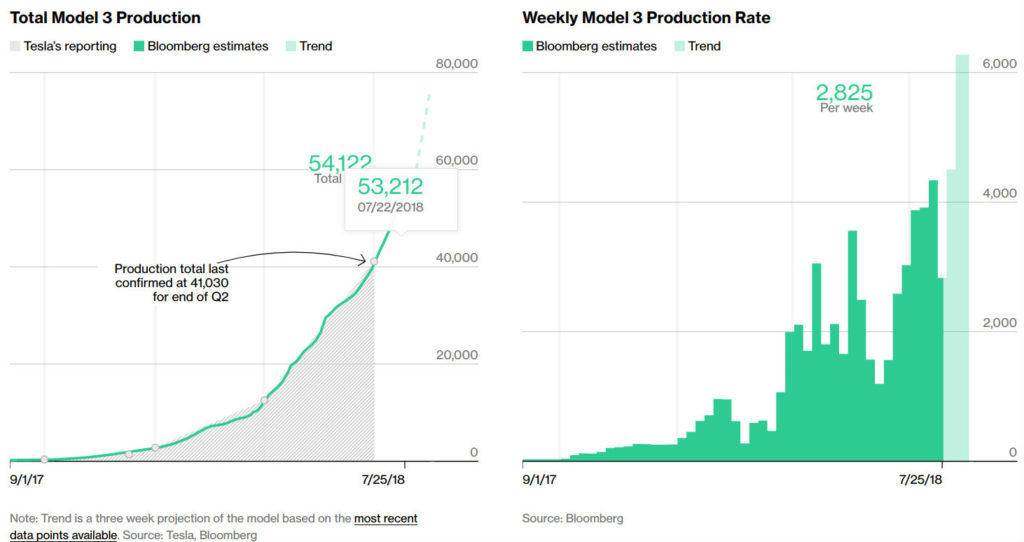

Investor's Corner
Tesla seems to be preparing the Model 3 for a 6,000/week production push
As Tesla heads towards its Q2 2018 financial results and earnings call, the electric car maker seems to be showing signs that it is gearing up for yet another significant Model 3 production push.
In an interview with Bloomberg Businessweek earlier this month, Elon Musk described the Model 3 ramp as a “bet-the-company” situation — a scenario in which the vehicle’s failure would equate to Tesla’s likely collapse. It was a risky gamble, and it gave Musk what he called “permanent mental scar tissue,” but with the company’s milestone at the end of Q2 2018, when it managed to produce 5,000 Model 3 per week, the end of Tesla’s manufacturing hell appears to be within reach.
To fully get out of production hell, Tesla would need to manufacture the Model 3 at scale and at a sustainable rate — a feat that has proven incredibly challenging for the electric car maker. Over the first half of July, signs were abounding that Tesla was once more defying the odds and maintaining its optimum manufacturing rate for the electric car, with mass sightings of Model 3 being transported, test drives for the vehicle being offered, and mass VIN registrations numbering more than 19,000 being filed in a two-week period. If Bloomberg‘s ever-evolving Model 3 tracker is any indication, however, Tesla’s production rate for the electric car appears to have tapered down recently.

While the recent production drop suggested in Bloomberg‘s tracker might appear negative, the publication’s model also forecasts an upcoming spike in Model 3 production. As of writing, a projection for the next few weeks points to Tesla manufacturing 6,000 Model 3 per week. Over the past few months, these instances of slowdowns followed by sudden bursts that reach record production levels have happened several times. In Q2, shutdowns of the Model 3 line corresponded to the installation of upgrades that gave Tesla the capacity to produce more vehicles than before.
Back in April, Tesla shut down the production of the Model 3 to roll out improvements that enabled the company to hit a manufacturing rate of 3,000-4,000 vehicles per week. In May, another set of upgrades were installed that allowed Tesla to get closer to its then-elusive target of producing 5,000 Model 3 per week. Based on the rationale behind Tesla’s previous production shutdowns, it appears that the electric car maker could be in the process of improving the capacity of its Model 3 line once more.
In a way, the slowdown in production reflected in Bloomberg‘s tracker was teased in Tesla Senior Director of Investor Relations Aaron Chew’s meeting with investors and analysts earlier this month. During the meeting, Chew reportedly noted that Tesla is aiming to hit a sustainable production rate of 5,000-6,000 Model 3 for the rest of the third quarter. After this point, Tesla’s ramp for the vehicle would be less radical, with the company reportedly targeting a pace of 7,000 cars per week for Q4 2018, and 10,000 Model 3 per week by mid-2019. Chew also reportedly noted that Tesla’s GA3 assembly line was only running at ~4,000 vehicles per week at the end of Q2 2018, and that the company was only able to hit its 5,000 Model 3 per week target because of an extra ~1,000 vehicles that were manufactured from GA4. Thus, Tesla’s recent slowdown in Model 3 production could correspond to the installation of upgrades for GA3 that would allow it to produce a steady rate of 5,000, or even 6,000 vehicles per week on its own. If these assumptions prove correct, Bloomberg‘s forecast pointing to a 6,000 Model 3 production week definitely becomes plausible.
Tesla is currently attempting to hit profitability this third quarter. To accomplish this goal, the Model 3’s production has to be optimized. Teardowns of the vehicle, both from Germany and in the United States have been unanimous in the conclusion that the Model 3 is profitable. Detroit’s Sandy Munro even noted that the Long Range RWD version of the vehicle could give Tesla as much as 36% worth of profits. At this point, the only thing standing between Tesla and profitability is its capability to scale and sustain the Model 3’s production. If the company achieves this, it would likely prove to be a hard-fought victory for Elon Musk and the Tesla team.

Investor's Corner
Tesla stock closes at all-time high on heels of Robotaxi progress

Tesla stock (NASDAQ: TSLA) closed at an all-time high on Tuesday, jumping over 3 percent during the day and finishing at $489.88.
The price beats the previous record close, which was $479.86.
Shares have had a crazy year, dipping more than 40 percent from the start of the year. The stock then started to recover once again around late April, when its price started to climb back up from the low $200 level.
This week, Tesla started to climb toward its highest levels ever, as it was revealed on Sunday that the company was testing driverless Robotaxis in Austin. The spike in value pushed the company’s valuation to $1.63 trillion.
Tesla Robotaxi goes driverless as Musk confirms Safety Monitor removal testing
It is the seventh-most valuable company on the market currently, trailing Nvidia, Apple, Alphabet (Google), Microsoft, Amazon, and Meta.
Shares closed up $14.57 today, up over 3 percent.
The stock has gone through a lot this year, as previously mentioned. Shares tumbled in Q1 due to CEO Elon Musk’s involvement with the Department of Government Efficiency (DOGE), which pulled his attention away from his companies and left a major overhang on their valuations.
However, things started to rebound halfway through the year, and as the government started to phase out the $7,500 tax credit, demand spiked as consumers tried to take advantage of it.
Q3 deliveries were the highest in company history, and Tesla responded to the loss of the tax credit with the launch of the Model 3 and Model Y Standard.
Additionally, analysts have announced high expectations this week for the company on Wall Street as Robotaxi continues to be the focus. With autonomy within Tesla’s sights, things are moving in the direction of Robotaxi being a major catalyst for growth on the Street in the coming year.
Elon Musk
Tesla needs to come through on this one Robotaxi metric, analyst says
“We think the key focus from here will be how fast Tesla can scale driverless operations (including if Tesla’s approach to software/hardware allows it to scale significantly faster than competitors, as the company has argued), and on profitability.”

Tesla needs to come through on this one Robotaxi metric, Mark Delaney of Goldman Sachs says.
Tesla is in the process of rolling out its Robotaxi platform to areas outside of Austin and the California Bay Area. It has plans to launch in five additional cities, including Houston, Dallas, Miami, Las Vegas, and Phoenix.
However, the company’s expansion is not what the focus needs to be, according to Delaney. It’s the speed of deployment.
The analyst said:
“We think the key focus from here will be how fast Tesla can scale driverless operations (including if Tesla’s approach to software/hardware allows it to scale significantly faster than competitors, as the company has argued), and on profitability.”
Profitability will come as the Robotaxi fleet expands. Making that money will be dependent on when Tesla can initiate rides in more areas, giving more customers access to the program.
There are some additional things that the company needs to make happen ahead of the major Robotaxi expansion, one of those things is launching driverless rides in Austin, the first city in which it launched the program.
This week, Tesla started testing driverless Robotaxi rides in Austin, as two different Model Y units were spotted with no occupants, a huge step in the company’s plans for the ride-sharing platform.
Tesla Robotaxi goes driverless as Musk confirms Safety Monitor removal testing
CEO Elon Musk has been hoping to remove Safety Monitors from Robotaxis in Austin for several months, first mentioning the plan to have them out by the end of 2025 in September. He confirmed on Sunday that Tesla had officially removed vehicle occupants and started testing truly unsupervised rides.
Although Safety Monitors in Austin have been sitting in the passenger’s seat, they have still had the ability to override things in case of an emergency. After all, the ultimate goal was safety and avoiding any accidents or injuries.
Goldman Sachs reiterated its ‘Neutral’ rating and its $400 price target. Delaney said, “Tesla is making progress with its autonomous technology,” and recent developments make it evident that this is true.
Investor's Corner
Tesla gets bold Robotaxi prediction from Wall Street firm
Last week, Andrew Percoco took over Tesla analysis for Morgan Stanley from Adam Jonas, who covered the stock for years. Percoco seems to be less optimistic and bullish on Tesla shares, while still being fair and balanced in his analysis.

Tesla (NASDAQ: TSLA) received a bold Robotaxi prediction from Morgan Stanley, which anticipates a dramatic increase in the size of the company’s autonomous ride-hailing suite in the coming years.
Last week, Andrew Percoco took over Tesla analysis for Morgan Stanley from Adam Jonas, who covered the stock for years. Percoco seems to be less optimistic and bullish on Tesla shares, while still being fair and balanced in his analysis.
Percoco dug into the Robotaxi fleet and its expansion in the coming years in his latest note, released on Tuesday. The firm expects Tesla to increase the Robotaxi fleet size to 1,000 vehicles in 2026. However, that’s small-scale compared to what they expect from Tesla in a decade.
Tesla expands Robotaxi app access once again, this time on a global scale
By 2035, Morgan Stanley believes there will be one million Robotaxis on the road across multiple cities, a major jump and a considerable fleet size. We assume this means the fleet of vehicles Tesla will operate internally, and not including passenger-owned vehicles that could be added through software updates.
He also listed three specific catalysts that investors should pay attention to, as these will represent the company being on track to achieve its Robotaxi dreams:
- Opening Robotaxi to the public without a Safety Monitor. Timing is unclear, but it appears that Tesla is getting closer by the day.
- Improvement in safety metrics without the Safety Monitor. Tesla’s ability to improve its safety metrics as it scales miles driven without the Safety Monitor is imperative as it looks to scale in new states and cities in 2026.
- Cybercab start of production, targeted for April 2026. Tesla’s Cybercab is a purpose-built vehicle (no steering wheel or pedals, only two seats) that is expected to be produced through its state-of-the-art unboxed manufacturing process, offering further cost reductions and thus accelerating adoption over time.
Robotaxi stands to be one of Tesla’s most significant revenue contributors, especially as the company plans to continue expanding its ride-hailing service across the world in the coming years.
Its current deployment strategy is controlled and conservative to avoid any drastic and potentially program-ruining incidents.
So far, the program, which is active in Austin and the California Bay Area, has been widely successful.








